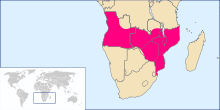
"A Portuguesa" is the national anthem of Portugal. The song was composed by Alfredo Keil and written by Henrique Lopes de Mendonça during the resurgent nationalist movement ignited by the 1890 British Ultimatum to Portugal concerning its African colonies. Used as the marching song of the failed republican rebellion of January 1891, in Porto, it was adopted as the national anthem of the newborn Portuguese Republic in 1911, replacing "Hino da Carta", the anthem of the deposed constitutional monarchy.

Manuel Deodoro da Fonseca was a Brazilian politician and military officer who served as the first president of Brazil. He was born in Alagoas in a military family, followed a military career, and became a national figure. Fonseca took office as provisional president after heading a military coup that deposed Emperor Pedro II and established the First Brazilian Republic in 1889, disestablishing the Empire. After his election in 1891, he stepped down the same year under great political pressure when he dissolved the National Congress. He died less than a year later.

The National Republican Guard or GNR is the national gendarmerie force of Portugal.

The Kingdom of Portugal under the House of Braganza was a constitutional monarchy from the end of the Liberal Civil War in 1834 to the Republican Revolution of 1910. The initial turmoil of coups d'état perpetrated by the victorious generals of the Civil War was followed by an unstable parliamentary system of governmental "rotation" marked by the growth of the Portuguese Republican Party. This was caused mainly by the inefficiency of the monarchic governments as well as the monarchs' apparent lack of interest in governing the country, aggravated by the British ultimatum for the abandonment of the Portuguese "pink map" project that united Portuguese West Africa and Portuguese East Africa.
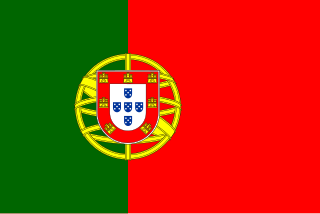
The Ditadura Nacional was the name given to the regime that governed Portugal from 1926, after the re-election of General Óscar Carmona to the post of President, until 1933. The preceding period of military dictatorship that started after the 28 May 1926 coup d'état is known as Ditadura Militar. After adopting a new constitution in 1933, the regime changed its name to Estado Novo. The Ditadura Nacional, together with the Estado Novo, forms the historical period of the Portuguese Second Republic (1926–1974).

João Pinheiro Chagas was a Portuguese politician, literary critic, propagandist, editor, and journalist. He was heavily involved in several rebellions condemning the monarchy and disseminating materials via pamphlets and newspaper in support of the Portuguese Republican Party. He was among the leaders of the 5 October 1910 revolution and the Lisbon Regicide, and later served as Ambassador to Paris for 14-years, and twice as interim prime minister of the Portuguese First Republic.

The 5 October 1910 revolution was the overthrow of the centuries-old Portuguese monarchy and its replacement by the First Portuguese Republic. It was the result of a coup d'état organized by the Portuguese Republican Party.

The Brazilian Naval Revolts, or the Revoltas da Armada, were armed mutinies promoted mainly by admirals Custódio José de Melo and Saldanha da Gama and their fleet of rebel Brazilian navy ships against the claimed unconstitutional staying in power of president Floriano Peixoto.
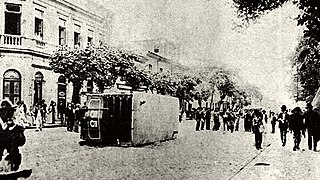
The Vaccine Revolt was a popular riot that took place between 10 and 16 November 1904 in the city of Rio de Janeiro, then the capital of Brazil. Its immediate pretext was a law that made vaccination against smallpox compulsory, but it is also associated with deeper causes, such as the urban reforms being carried out by mayor Pereira Passos and the sanitation campaigns led by physician Oswaldo Cruz.

Antonio Manuel Maria Coelho (1857–1943) was a Portuguese military officer of the Portuguese Army and politician during the period of the Portuguese First Republic. In January 1891, he had been one of the leading revolutionaries during the Porto republican revolt. Among other posts, he served as governor of Portuguese Angola and governor of Portuguese Guinea. He became Prime Minister after the Noite Sangrenta terrorist assassinations of prominent state figures on 19 October 1921. A Freemason, he was co-author, along with João Chagas, of the work História da Revolta do Porto.

The Federalist Revolution was a civil war that took place in southern Brazil between 1893 and 1895, fought by the federalists, opponents of Rio Grande do Sul state president, Júlio de Castilhos, seeking greater autonomy for the state, decentralization of power by the newly installed First Brazilian Republic and, arguably, the restoration of the monarchy.
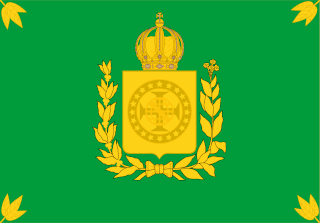
The Armed Forces of the Empire of Brazil were the overall unified military forces of the Empire of Brazil. The Brazilian military was first formed by Emperor Dom Pedro I to defend the new nation against the Portuguese in the Brazilian War of Independence. The Army and Armada were commissioned in 1822 with the objective of defeating and expelling the Portuguese troops from Brazilian soil.

The decline and fall of Pedro II of Brazil took place in the 1880s. It coincided with a period of economic and social stability and progress for the Empire of Brazil, with the nation achieving a prominent place as an emerging power in the international arena.
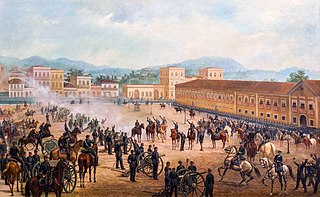
The Proclamation of the Republic was a military coup d'état that established the First Brazilian Republic on November 15, 1889. It took over the constitutional monarchy of the Empire of Brazil and ended the reign of Emperor Pedro II.

The Monarchy of the North, officially the Kingdom of Portugal, was a short-lived revolution against the First Portuguese Republic and a monarchist government that occurred in Northern Portugal in early 1919. It was based in Porto and lasted from 19 January to 13 February 1919. The movement is also known by the derogatory term Kingdom of Traulitânia.

The Imperial Brazilian Army was the name given to the land force of the Empire of Brazil. The Brazilian Army was formed after the independence of the country from Portugal in 1822 and reformed in 1889, after the republican coup d'état that created the First Brazilian Republic, a dictatorship headed by the army.

The São Paulo Revolt of 1924 was a Brazilian conflict with characteristics of a civil war, triggered by tenentist rebels to overthrow the government of president Artur Bernardes. Initially started in the city of São Paulo on 5 July, the revolt expanded to the interior of the state and inspired other uprisings. The urban combat ended in a loyalist victory on 28 July. The rebels' withdrawal, until September, prolonged the rebellion with the Paraná Campaign.

The February 1927 Revolt, sometimes also referred to as the February 1927 Revolution, was a military rebellion that took place between February 3 and 9, 1927, centered in Porto, the city where the insurgents' command center was installed and fought the main challenges. The revolt, led by Adalberto Gastão de Sousa Dias, ended with the surrender and arrest of the rebels and resulted in about 80 deaths and 360 injuries in Porto and more than 70 deaths and 400 injuries in Lisbon. It was the first consequent attempt to overthrow the Military Dictatorship that was then consolidated in Portugal following the 28 May 1926 coup d'état, which occurred nine months earlier, initiating a set of insurrectionary movements that became known as the Reviralhism.

On October 4, 1963, the President of Brazil João Goulart sent to the National Congress a request for a state of exception for 30 days throughout the national territory. Citing as justification the crisis and the threat of internal disturbances, it was based on the resistance of Congress to approve the reforms desired by the Executive, as well as the need to assert itself before the opposition. Its immediate antecedent was an interview by Carlos Lacerda, governor of Guanabara, to the American newspaper Los Angeles Times. Lacerda spoke explicitly of the possibility of Goulart being deposed by the military. The Ministers of War, Navy and Air Force, outraged, wanted forceful action against the governor, who was a right-wing oppositionist. The state of exception would possibly be accompanied by federal intervention in some states, and is associated with a military plan to arrest Lacerda and an operation in Pernambuco, governed by leftist Miguel Arraes, who was against the measure. The proposal was rejected by both the right and the left, who felt they could also be targeted by the exceptional powers. Without support, the President withdrew the proposal on October 7, and his political position was weakened.
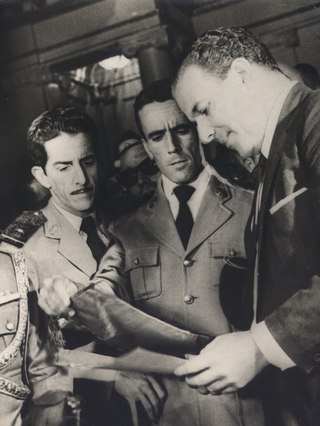
The meeting at the Automóvel Clube was a solemnity of sergeants of the Military Police and Armed Forces of Brazil, on March 30, 1964, in Rio de Janeiro, at which President João Goulart gave a speech. Taking place amid the repercussions of the 1964 Sailors' Revolt, it was one of the immediate factors in the coup d'état that began the following day.


